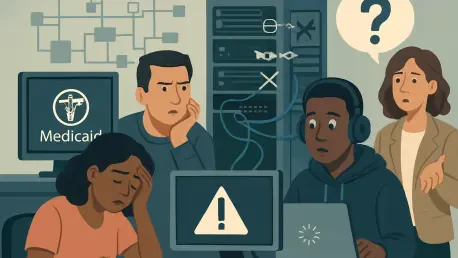The landscape of Medicaid in the United States stands at a critical juncture, with a staggering 18.5 million enrollees across 42 states and Washington, D.C., grappling with stringent work requirements that mandate at least 80 hours per month of work, study, volunteering, or job training to maintain eligibility. Introduced through federal legislation during the Trump administration as part of a broader fiscal strategy, these rules aim to curb costs within a system that serves as a lifeline for millions of low-income individuals. The magnitude of this policy shift has sparked intense debate over its implications for healthcare access and administrative feasibility.
To address compliance verification, the federal government has committed $200 million toward developing technological solutions, with oversight from the Centers for Medicare & Medicaid Services (CMS) alongside state agencies. This infusion of funds reflects a belief that digital tools can streamline the process of tracking enrollee activities, thereby reducing administrative burdens and ensuring accountability. However, the intersection of technology with such a sprawling, decentralized program raises questions about whether innovation can truly bridge the gap between policy intent and practical execution.
At its core, this initiative is tied to broader fiscal priorities, including efforts to redirect savings toward other governmental objectives. Technology is positioned as a cornerstone of this cost-saving measure, promising efficiency in a system often criticized for bureaucratic inefficiencies. Yet, as states scramble to integrate these tools, the reality of diverse administrative capacities and enrollee needs casts a shadow over the optimistic projections of federal planners.
Current Developments and Pilot Programs
Emerging Tools and Pilot Initiatives
In an effort to test the viability of technological solutions, pilot programs in Louisiana and Arizona have been launched as flagship examples of innovation in Medicaid compliance verification. Louisiana’s initiative focuses on mobile-first outreach, sending text messages to enrollees to prompt wage reporting, while Arizona experiments with direct payroll connections to simplify income checks. Federal officials have often framed these efforts with buzzwords like artificial intelligence, though the actual tools appear to rely more on straightforward data integration than cutting-edge algorithms.
Despite the hype, early results paint a less rosy picture. In Louisiana, a pilot targeting over 13,000 enrollees yielded responses from just 894 individuals, a dismal 7% participation rate that underscores significant barriers to engagement. Meanwhile, Arizona’s program has been narrowly scoped to the Supplemental Nutrition Assistance Program (SNAP) rather than Medicaid, limiting its relevance to the broader work rule challenge and raising concerns about applicability.
These initial efforts highlight a disconnect between ambitious rhetoric and ground-level outcomes. While the tools aim to modernize a cumbersome process, their limited success in early testing phases suggests that deeper issues—beyond mere technological capability—may hinder their effectiveness. The focus on specific states also prompts curiosity about whether these models can adapt to the diverse needs of other regions.
Early Results and Engagement Metrics
Delving into the performance data from these pilots reveals a troubling lack of transparency and scalability. Louisiana’s low response rate not only reflects enrollee disengagement but also points to potential flaws in communication strategies, as many recipients may not have received or understood the outreach. This raises critical questions about the adequacy of current methods in reaching a population often facing socioeconomic challenges.
In Arizona, the situation is equally opaque, with even local nonprofits assisting with SNAP enrollment unaware of the pilot’s existence. This lack of coordination and information sharing at the community level further complicates the assessment of the program’s impact. Without clear metrics or publicized outcomes, stakeholders are left guessing about the initiative’s progress and potential for broader application.
Looking ahead, these early indicators suggest that scaling such technological interventions across multiple states could encounter systemic roadblocks. The combination of poor engagement and limited visibility in pilot states hints at underlying issues in enrollee access and administrative outreach. Whether these results signal a need for fundamental redesign or merely temporary setbacks remains a pressing concern for policymakers.
Critical Challenges in Implementation
The deployment of technology to enforce Medicaid work rules faces a multitude of obstacles that threaten to undermine its objectives. Low enrollee engagement, as evidenced by pilot data, is compounded by practical barriers such as unreliable internet access in rural areas, where many Medicaid recipients reside. Additionally, a widespread lack of awareness about the tools themselves means that even functional systems may fail to reach their intended users.
Administrative complexities further exacerbate the situation, given Medicaid’s decentralized state-federal structure. States, tasked with day-to-day management, often operate with outdated eligibility systems and understaffed agencies, creating a patchwork of capabilities that hinders uniform technology adoption. This fragmented environment risks inconsistent implementation, where some regions may lag far behind others in meeting federal mandates.
Perhaps most alarming is the potential for eligible individuals to lose coverage due to technological shortcomings or inadequate outreach. The current narrow focus on income verification overlooks other compliance criteria, such as volunteering or exemptions for specific circumstances, leaving gaps in the system. To address these challenges, strategies like enhanced communication campaigns, a broader technological scope to cover all compliance aspects, and targeted support for state-level constraints could provide a path forward, though their feasibility remains uncertain.
Regulatory and Policy Landscape
The federal legislation driving Medicaid work requirements, embedded within a larger tax and spending law, projects a significant reduction in coverage, with the Congressional Budget Office estimating a loss of 10 million enrollees by 2034. This policy, aimed at fiscal restraint, places immense pressure on states to comply with tight timelines for system adoption, with full implementation expected within the coming year. The scale of this transformation underscores the high stakes for both administrators and recipients.
Oversight from CMS, alongside influential figures like Mehmet Oz, seeks to guide this transition, yet the day-to-day burden falls on states, creating a fragmented implementation landscape. This division of responsibility often results in regulatory gaps, where federal directives lack the granular control needed to ensure consistent state-level execution. Varying capacities among states to integrate new tools further complicate the rollout, risking delays and disparities.
Compliance challenges are intensified by the potential for policy shifts to disrupt coverage, especially as states race against deadlines. The absence of robust federal mechanisms to standardize technology adoption means that some areas may struggle more than others, potentially exacerbating inequities in healthcare access. Addressing these regulatory inconsistencies will be crucial to mitigating the risk of widespread disenrollment among vulnerable populations.
Future Outlook for Technology in Medicaid Compliance
As the integration of technology into Medicaid work rules progresses, emerging tools like mobile-first platforms hold promise for streamlining verification processes if scaled effectively. These innovations could simplify income reporting and reduce administrative overhead, provided they overcome current limitations in reach and usability. The potential for public-private partnerships to drive further advancements also looms on the horizon, offering a possible avenue for accelerated development.
However, significant hurdles remain, particularly around consumer challenges such as digital literacy and connectivity among enrollees. Many Medicaid recipients face barriers to accessing online tools, which could undermine even the most sophisticated systems. Market disruptors, including advancements in digital access infrastructure, might help address these gaps, though their impact depends on coordinated efforts across multiple sectors.
Influencing factors like federal funding constraints and state administrative readiness will shape the trajectory of this initiative. Broader economic conditions affecting healthcare access add another layer of complexity, as do expert perspectives that balance cautious optimism from developers with critical warnings from researchers about unintended consequences. The path forward will likely require a delicate balance of innovation, investment, and policy refinement to ensure technology serves rather than hinders Medicaid enrollees.
Conclusion and Recommendations
Reflecting on the findings, it becomes evident that the journey to integrate technology into Medicaid work rule compliance encounters substantial hurdles, with pilot programs in Louisiana and Arizona exposing critical gaps in engagement and effectiveness. The looming risk of coverage loss for millions of eligible individuals due to technological and administrative barriers paints a sobering picture of the stakes involved. These early setbacks highlight an urgent need for solutions that extend beyond mere innovation to address systemic inequities.
Moving forward, actionable steps should prioritize increasing transparency in pilot outcomes to build trust and inform strategy, while expanding the scope of technological solutions to encompass all compliance criteria, not just income verification. Enhanced outreach efforts tailored to vulnerable populations, coupled with investments in digital access for rural and underserved areas, emerge as vital considerations. Ultimately, safeguarding access to essential healthcare for Medicaid enrollees demands a concerted push for robust, inclusive strategies that can adapt to the diverse realities of those the system aims to serve.









